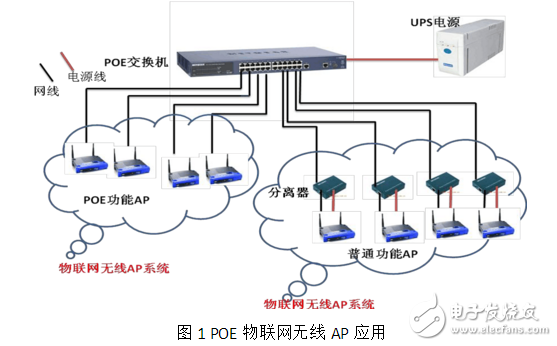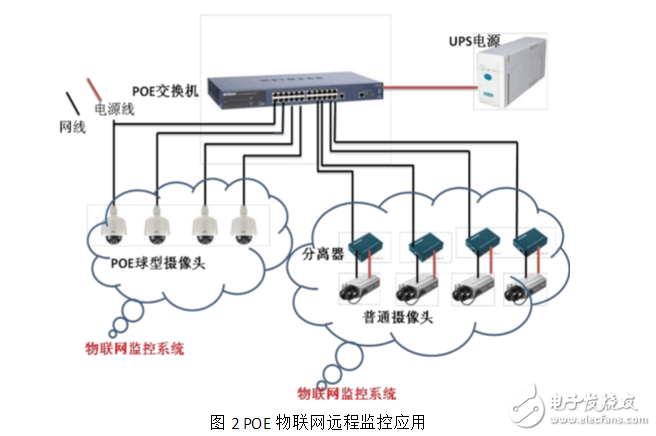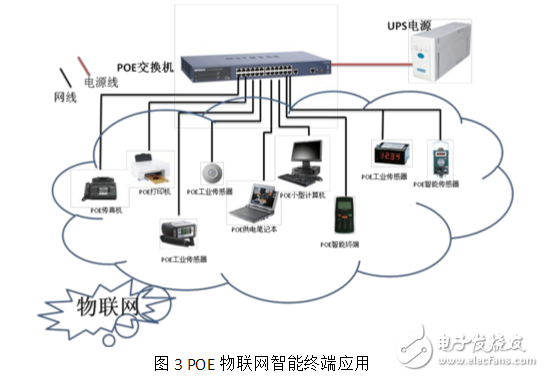With the advent of the Internet of Things era, various applications of the Internet of Things are constantly increasing and improving, and the demand for basic power supplies is more urgent. This paper mainly discusses the application scenarios and development trends of POE technology in the Internet of Things.
I. OverviewThe Internet of Things equips sensors to various real objects such as power grids, railways, bridges, tunnels, highways, buildings, water supply systems, dams, oil and gas pipelines, and household appliances, and is connected via the Internet to run specific programs for remote control. Or achieve direct communication of things. Through the Internet of Things, you can use the central computer to centrally manage and control machines, equipment, and personnel. You can also remotely control home devices and cars, as well as find applications to prevent location and prevent theft of items. In many of these applications, a power supply technology is not available, and POE (POwerOverEthernet) is a technology that can transmit power and data to a device through a twisted pair cable in an Ethernet network. Through this technology, including VoIP, wireless base stations, network cameras, hubs, smart terminals, modern smart office equipment, computers, etc., all of them can be powered by POE technology to complete the operation of various devices. The electronic equipment that is powered by the network can be used without an additional power outlet, so the time and money for configuring the power cord can be eliminated, and the cost of the entire device system is relatively reduced.
With the wide application of Ethernet, RJ-45 network sockets are widely used all over the world, so various POE devices are compatible. POE does not need to change the cable structure of the Ethernet circuit to operate. Therefore, the POE system not only saves cost, but also has the ability to remotely electrify and power off the wiring. The “Yulipu†intelligent power supply solves the problem well. The power supply challenges required for networked terminals will play a very important role in the future development of the Internet of Things.
Second, the main application of POE in the Internet of ThingsWith the development of technology and application, the connotation of the Internet of Things has been expanding, creating a new understanding. The Internet of Things is an extension of the communication network and the Internet and its network extension. It uses the sensing technology and intelligent devices to perceive the physical world. Network transmission interconnection, calculation, processing and knowledge mining, to achieve human and material, material and material information interaction and seamless connection, to achieve real-time control, precise management and scientific decision-making of the physical world. Therefore, the network will no longer passively meet the needs of users, but actively sense changes in user scenarios and exchange information to provide personalized services for users. The following introduces the current "Ulipu", the main application scenarios of POE technology in the Internet of Things:
1. Application of POE wireless AP in Internet of Things
The impact of wireless network technology on people is undisputed. The application range of wireless LAN is more and more wide, in large offices, smart warehouses, university campuses, shopping malls, airports, convention centers, hotels, airports, hospitals, Bars, coffee houses, etc., to meet people's needs to access the Internet anytime, anywhere. The most important task in deploying a wireless network is the reasonable and efficient installation of a wireless AP (AccessPOint). The TG cloud platform can provide a complete set of management in a centralized and reasonable manner. In the larger wireless network coverage projects, the number of wireless APs is large and distributed in various parts of the building. The AP generally needs a network cable to connect the switch, and needs to be connected externally. DC power supply. Solving power and management on-site will greatly increase the cost of construction and maintenance. The “Ulipu†power supply switch solves the problem of centralized power supply of wireless APs through network cable power supply (POE), which can greatly solve the problem of local power supply and subsequent AP management encountered during project construction. When the local power outage is avoided, individual APs cannot be normal. In this solution, the AP device must have a device that supports the 802.3af/802.3af protocol to achieve the power supply function of the network cable. If the AP does not support the 802.3af/802.3af protocol function, you can directly add data and POE synthesizer to complete this power supply function. As shown in Figure 1:

2. Application of POE remote monitoring in the Internet of Things
In recent years, due to the rapid development of social economy and information technology, various industries in the country have produced unprecedented demands for video surveillance. The application field is becoming more and more extensive. In addition to special industries such as finance, government, transportation, etc., digital monitoring has been applied or is being implemented in communities, hotel public places, factories and shopping malls. The scale and radiation area is getting bigger and bigger. A typical example is the “Peace China†project, which covers the entire city and has tens of thousands of cameras. Video surveillance products have also evolved from local DVR to IPCamera networks.
However, the installation of network video surveillance equipment is subject to environmental constraints, which seriously affects the development of network video surveillance. In addition to the need to transmit video signals over a network cable, network cameras used in network video surveillance must provide sufficient power throughout the day. In the implementation process, it is often the case that the installation location of the camera has to be redesigned because a stable power supply cannot be provided, and redesigning the installation location may result in a monitoring dead angle, making the security monitoring meaningless.
Normally, a network camera that works normally needs to connect two wires, one cable, and one wire. The following conditions can cause the network surveillance camera to fail to install:
1. There is no power supply in the camera installation position.
2, the camera is installed at the location of the power supply, but it is the lighting power supply, can not provide all-weather power supply.
The above situation that the network camera cannot be installed occurs in the power supply problem of the network camera. In order for the network camera to be installed correctly at the intended location, the power supply problem of the network camera must be solved. Since power cannot be supplied normally, you should consider using a network cable to power the camera. After all, deploying a network cable is much easier than deploying a strong wire, and if the power is supplied by the network cable, the network camera can work normally as long as the power of the data switch is not interrupted. . Using a network cable to power a network camera can be summarized as follows:
1. The network camera supports the 802.3af/802.3af protocol. You can directly use the POE power supply device to supply power to the network camera through the network cable.
2. The network camera does not support the 802.3af/802.3af protocol. It cannot be powered directly by the POE device. At this time, another supporting equipment, the separator, is needed. The function of the splitter is to separate the network cable integrated with power into a pure data network cable and power cable. This completes the separation of data and power, reaching a network cable that transmits data and provides power.
as shown in picture 2:

3. Application of POE intelligent terminal in Internet of Things
When making a call at home, the call will not be interrupted if the power is suddenly turned off. This is because the power supply of the telephone terminal is directly supplied by the telephone company (office) switch through the telephone line. Imagine that if the industrial site sensors, controllers, and smart terminal actuators in the Internet of Things can also be powered directly by Ethernet, the overall cost of wiring, power, and labor may drop a lot. Extending monitoring to many remote applications is a vision that POE technology has portrayed in the IoT industry.
In 2003 and 2009, the IEEE approved the 802.3af and 802.3at standards, respectively, which clearly defined power detection and control issues in remote systems, and used Ethernet cables to IP phones, security systems, and wireless routers, switches, and hubs. The way in which devices such as LAN access points are powered is specified. The release of IEEE802.3af and IEEE802.3at has greatly promoted the development and application of POE technology. At present, “Yulipu†has launched industrial Ethernet products based on POE technology to provide reliable and stable power supply for various network terminals in the IoT industrial control, such as temperature detection terminals, humidity detection terminals, and signal control terminals.
As shown in Figure 3:

flyphotography
SHAOXING SHANGYU FEIXIANG PHOTOGRAPHIC CO.,LTD , https://www.flying-photography.com